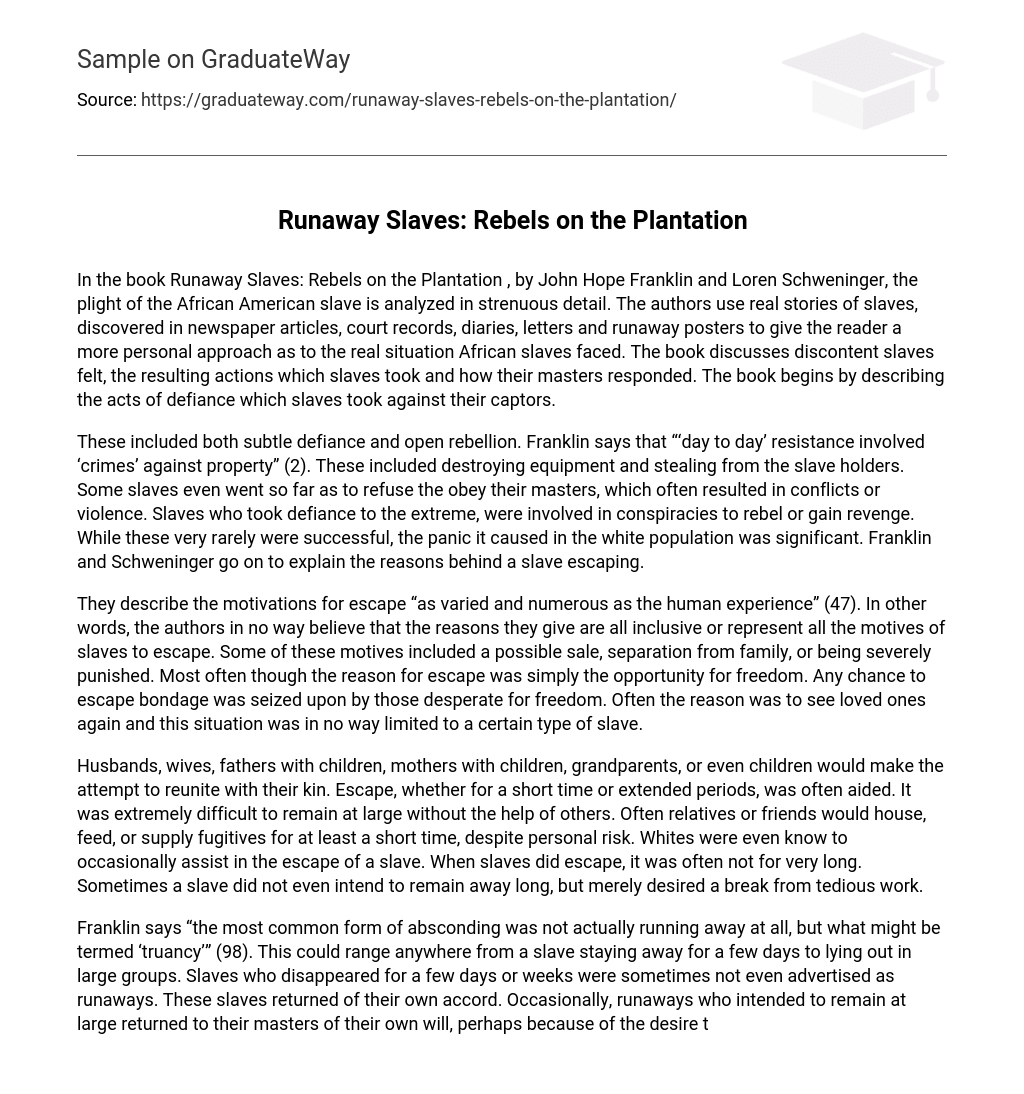In the book Runaway Slaves: Rebels on the Plantation , by John Hope Franklin and Loren Schweninger, the plight of the African American slave is analyzed in strenuous detail. The authors use real stories of slaves, discovered in newspaper articles, court records, diaries, letters and runaway posters to give the reader a more personal approach as to the real situation African slaves faced. The book discusses discontent slaves felt, the resulting actions which slaves took and how their masters responded. The book begins by describing the acts of defiance which slaves took against their captors.
These included both subtle defiance and open rebellion. Franklin says that “‘day to day’ resistance involved ‘crimes’ against property” (2). These included destroying equipment and stealing from the slave holders. Some slaves even went so far as to refuse the obey their masters, which often resulted in conflicts or violence. Slaves who took defiance to the extreme, were involved in conspiracies to rebel or gain revenge. While these very rarely were successful, the panic it caused in the white population was significant. Franklin and Schweninger go on to explain the reasons behind a slave escaping.
They describe the motivations for escape “as varied and numerous as the human experience” (47). In other words, the authors in no way believe that the reasons they give are all inclusive or represent all the motives of slaves to escape. Some of these motives included a possible sale, separation from family, or being severely punished. Most often though the reason for escape was simply the opportunity for freedom. Any chance to escape bondage was seized upon by those desperate for freedom. Often the reason was to see loved ones again and this situation was in no way limited to a certain type of slave.
Husbands, wives, fathers with children, mothers with children, grandparents, or even children would make the attempt to reunite with their kin. Escape, whether for a short time or extended periods, was often aided. It was extremely difficult to remain at large without the help of others. Often relatives or friends would house, feed, or supply fugitives for at least a short time, despite personal risk. Whites were even know to occasionally assist in the escape of a slave. When slaves did escape, it was often not for very long. Sometimes a slave did not even intend to remain away long, but merely desired a break from tedious work.
Franklin says “the most common form of absconding was not actually running away at all, but what might be termed ‘truancy’” (98). This could range anywhere from a slave staying away for a few days to lying out in large groups. Slaves who disappeared for a few days or weeks were sometimes not even advertised as runaways. These slaves returned of their own accord. Occasionally, runaways who intended to remain at large returned to their masters of their own will, perhaps because of the desire to return to love ones or if they needed help. When a slave was on the run, they often stole food, clothing, or supplies from whites.
Stealing was not the only crime committed by runaways. Sometimes gangs of outlaws were known to harass plantations or homes by destroying property, killing livestock, and frightening whites. Individual crimes were also known to occur such as murder, rape, and assault. However, a vast majority of these crimes were greatly exaggerated by whites. Often assault or murder was the result of a confrontation initiated by a white person. These physical crimes against a slaveholder or overseer were the slave acting in self defense or lashing out as a reaction to their situation.
Rape could be accused by any women and, while it did occur, women sometimes exaggerated. Franklin says that punishment “did not slow the pace of murder, stealing and other plantation crimes” (96). Slaves did what was necessary to survive or what they felt was an act of defiance. The results of running away or committing crimes was often extremely steep. Runaways who were captured could face jail time, being sold away from their families, or physical punishment such as lashes. Runaways who resisted were often shot. Commiting crimes while on the run resulted in even greater penalties.
A slave who was even accused of rape, murder, or assault, could easily end up dead. If a slave managed to avoid capital punishment, either due to luck or the influence of his owner, he still faced intense retribution from his master. However, severe punishment did not detour thousands of slaves from making escape attempts. When slaves escaped, they attempted to travel to a variety of places. Some attempted to return to loved ones or to return to the areas they were raised. In these cases, the master often knew where the slave was headed and easily recaptured them.
Others made a break for the North or West, where they may be able to live in a free state. Still others simply went where they would be least likely to be found, even staying within their own county. Overall this book is very eye opening. As a member of the white community, I had never truly considered what it would be like to be held in slavery. This book used the story of everyday life in the South; about Peter, who ran away for what appeared to his owner to be for no reason (69) or Tennessee slave who escaped even though he had never been more than 17 miles from his plantation (109).
An interesting observation about the perspective of this book is that since the research mostly came from white sources, the language is often degrading towards the slaves. References to slaves as being ungrateful, lazy, or of bad character are common throughout the book. This book is a great and easy read that translates more as a story than as a history text and makes the reader question what they would do if faced with the same situations.





